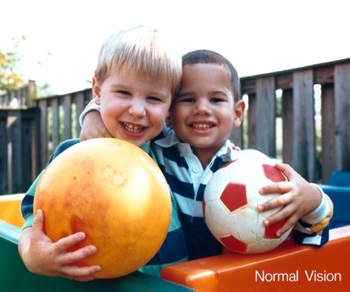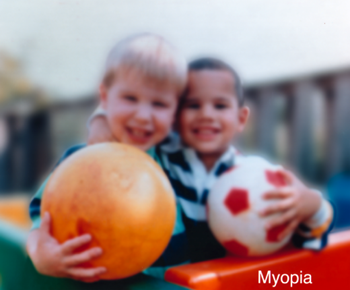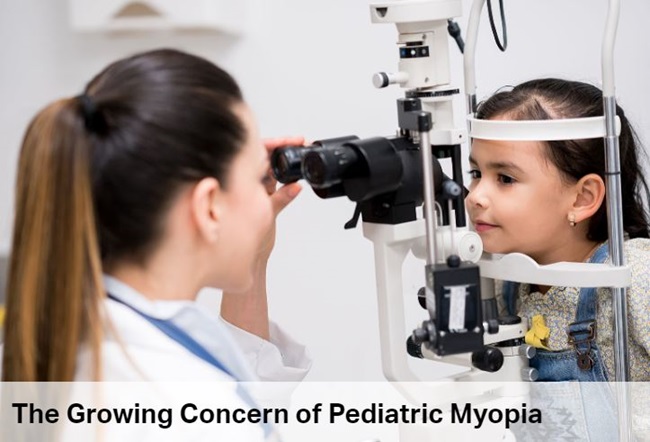Myopia is the medical term for nearsightedness, one of the most common eye conditions. People with myopia can see close objects clearly, but objects farther away look blurred. Myopia occurs when either the eye is longer than normal from front to back or the cornea at the front of the eye is steeply curved.
In recent years, the incidence of myopia has been increasing among children. Currently, one in four parents have a child with myopia, and 75 percent of those children are diagnosed with myopia between the ages of 3 and 12. Overall, 50 percent of all people worldwide have some degree of myopia.
In children, myopia treatment historically consisted of correcting the existing myopia with glasses and contact lenses. However regular eye glasses and contact lenses do not stop the growth of the eye and do not stop the myopia increase. Now treatments are available to slow the progression of myopia and prevent it from getting worse over time. Cutting-edge treatments available at Bascom Palmer's management of myopia clinical service include myopia control spectacles, low-dose atropine eye drops, and special contact lens fits, including one-day disposable contact lenses. It is reassuring to know that with all these options, we have a treatment choice that will be successful for each child.

What causes myopia?
At this time, eye health experts aren’t exactly sure why rates of pediatric myopia are rising, but they do have some theories. The American Academy of Pediatrics notes that kids spending more time indoors and doing close-up tasks like playing video games, using tables and phones or working on computers might be playing a role in the rise.
How is myopia diagnosed?
Parents often mistakenly think vision screenings at school or the pediatrician's office are adequate enough to diagnose vision problems. Routine school screenings provide less than 4% of the eye tests needed to help children see, and they miss up to 75% of children with vision problems. The best way to detect myopia and any other vision issues is through regular in-person, comprehensive eye exams. Children with siblings or other family members who have myopia should see an eye doctor early in life, age 13 to 18 months, to detect myopia before it progresses.
Treatments
Treatments to Clear Vision
Traditional myopia treatments focus on making your child see things more clearly but do not stop progression. These include the following:
- Glasses - Glasses are still the standard treatment for most cases of myopia in children. Your child’s eye doctor will provide a prescription to help them see things that are far away more clearly. Your child may need to wear them all the time or occasionally depending on the severity of their myopia. The eye doctor can help fulfill any specific needs for your child when it comes to eyeglass fit, sports goggles for activities, or other individual needs.
- Contact Lenses - A doctor examines the eyes to see if they are properly aligned and if there is any muscle dysfunction.
Treatments to Manage Myopia
Single vision contact lenses and eyeglasses do not slow myopia progression, so your child is at risk of serious eye conditions later in life. Now treatments are focused on slowing the progression of myopia and preventing it from getting worse over time. These include the following:
- Eye Drops - Low-dose atropine eye drops can be given to children. When taken each night around bedtime they appear to slow the progression of myopia by preventing the eye from lengthening.
- Myopia Management Contact Lenses - These specialty contact lenses look and feel like other contact lenses. Your child wears contact lenses each day and throws the contact lens out each night. These contact lenses have been proven safe for children to wear. These lenses provide clear vision with the added benefit of slowing myopia progression. Most myopia management contact lenses work via peripheral defocus. This means the contact lens focuses distance vision, while intentionally defocusing, or blurring, peripheral (side) vision.
- Orthokeratology -Also known as Ortho-K, this treatment involves your child wearing a different type of specialty contact lens while they sleep each night. The Ortho-K lenses flatten the cornea during sleep, which helps improve your child’s distance vision and slows the progression of myopia over time.
- Lifestyle Factors - According to experts, having your child limit their screen time and spend more time playing outside can also help reduce the risk of myopia or slow its progression.
Early treatment means lower myopia and a better quality of life. Detecting myopia early will also greatly reduce the chance of myopia-related eye disease and vision loss.
Related Stories
With a growing public health concern of pediatric myopia, it is important to understand your child’s eye health and what you can do to slow down the progression of pediatric myopia.
Why Choose Bascom Palmer Eye Institute?
#1 in the Nation. When you choose Bascom Palmer, you choose America’s No. 1 eye care provider, according to U.S. News & World Report. Our respected physicians, advanced treatments, and groundbreaking research drive high-quality patient care.
Patient-Centered Care. When your child’s vision is compromised, it can affect every aspect of their routine. Our compassionate eye care professionals understand your child’s concerns and address them with a fast, accurate diagnosis, and effective treatment.
University-Based Medicine. Whether your child’s condition is common or complex, when you choose Bascom Palmer, part of the University of Miami, they receive the finest care, state-of-the-art technology, the latest treatments, and access to clinical research trials.
Skilled Pediatric Specialists. Our pediatric ophthalmologists and optometrists use special techniques to make eye exams and treatments easier for babies and children.
Questions? We're here to help.
Our appointment specialists are ready to help you find what you need. Contact us today.

